Jan 27, 2023
When to use At, in and on in a sentence
Preposition Basics
A preposition is a word or group of words used before a noun, pronoun, or noun phrase to show direction, time, place, location, spatial relationships, or to introduce an object. Some examples of prepositions are words like "in," "at," "on," "of," and "to."
1. Prepositions in English are highly idiomatic ( idiomatic-adjective using, containing, or denoting expressions that are natural to a native speaker.) "distinctive idiomatic dialogue" Although there are some rules for usage, much preposition usage is dictated by fixed expressions. In these cases, it is best to memorize the phrase instead of the individual preposition.
A Few Rules
Prepositions of Direction
To refer to a direction, use the prepositions "to," "in," "into," "on," and "onto."
2. When English speakers talk about time and place, there are three little words that often come up: "in", "on", and "at". These common words are prepositions that show a relationship between two words in a sentence.
But these little two-letter prepositions seem to create confusion. Here are a few rules to help you understand when to use in, on, and at in a sentence.
For describing time and place, the prepositions "in", "on", "and" at go from general to specific.
3. Prepositions and Time
Let’s start by looking at how we talk about time. English speakers use "in" to refer to a general, longer period of time, such as months, years, decades, or centuries. For example, we say “in April,” “in 2015” or “in the 21st century.”
Moving to shorter, more specific periods of time, we use "on" to talk about particular days, dates, and holidays . You may hear, “I went to work on Monday,” or “Let’s have a picnic on Memorial Day.”
4. For the most specific times, and for holidays without the word “day,” we use "at". That means you will hear, “Meet me at midnight,” or “The flowers are in bloom at Easter time.”
When English speakers refer to a place, we use "in" for the largest or most general places. You can say that “VOA is located in Washington, D.C.” And “for the best food, try the restaurants in Chinatown.”
For more specific places, like certain streets, we use the preposition "on". You may know that President Biden lives on Pennsylvania Avenue in Washington, D.C.
5. Finally, we get to the most specific places. For exact addresses or intersections, we use the preposition "at". If I invited you to visit us here at VOA, I would say, “Come to my office at 330 Independence Avenue.” To be exact, it’s at the corner of Independence and 3rd Street.”
In English, though, there is always an ‘exception to the rule."
When talking about transportation, things get a little hard to understand. We use on for public vehicles like buses or trains, but also for smaller ones like a bicycle. “I rode there on my bicycle.” However, you ride in a car.
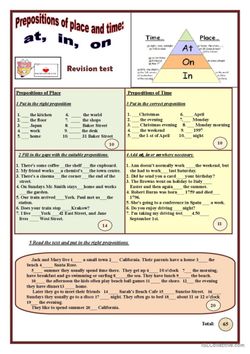
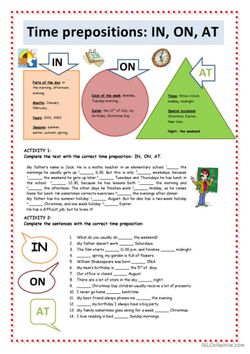
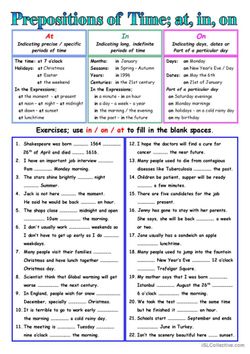
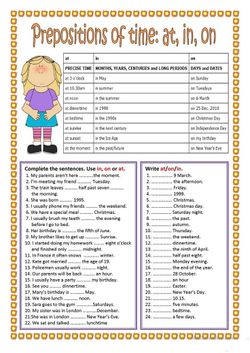
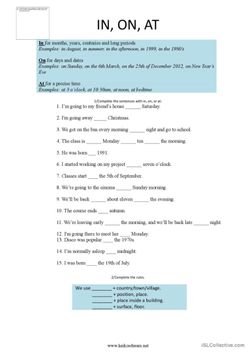
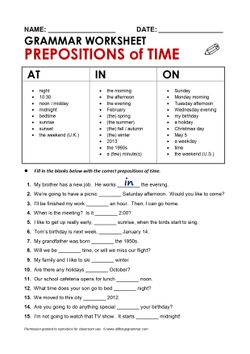
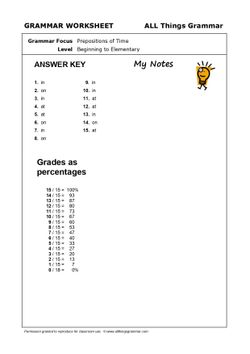
16 Question Strips
1. At what time do you usually get up in the morning?
2. Do you ever get up at sunrise? Why? / Why not?
3. At what time do you usually go to work or school?
4. What time do you usually get up on weekends?
5. What do you usually do on weekday afternoons?
6. What do you usually do on weekday evenings?
7. Do you always eat lunch at noon? What do you usually eat?
8. Do you ever take a nap in the afternoon? Why? / Why not?
9. Is your birthday in June? If ‘no”, when is your birthday?
10. How do you like to relax at bedtime?
11. Do you ever watch TV at night? Why? / Why not?
12. Can you remember what you did on Tuesday afternoon?
13. Do you ever go skiing in winter? Why? / Why not?
14, At what time is sunset?
15. Were you born in the 1990’s? If “no”, when were you born?
16. Do you ever eat food at midnight? Why? / Why not?
Examples:
She drove to the store.
Don’t ring the doorbell. Come right in(to) the house.
Drive on(to) the grass and park the car there.
Prepositions of Time
To refer to one point in time, use the prepositions "in," "at," and "on."
Use "in" with parts of the day (not specific times), months, years, and seasons.
He reads in the evening.
The weather is cold in December.
She was born in 1996.
We rake leaves in the fall.
Use "at" with the time of day. Also use "at" with noon, night, and midnight.
I go to work at 8:00.
He eats lunch at noon.
She often goes for a walk at night.
They go to bed at midnight.
Use "on" with days.
I work on Saturdays.
He does laundry on Wednesdays.
To refer to extended time, use the prepositions "since," "for," "by," "during," "from…to," "from…until," "with," and "within."
I have lived in Minneapolis since 2005. (I moved there in 2005 and still live there.)
He will be in Toronto for 3 weeks. (He will spend 3 weeks in Toronto.)
She will finish her homework by 6:00. (She will finish her homework sometime between now and 6:00.)
He works part time during the summer. (For the period of time throughout the summer.)
I will collect data from January to June. (Starting in January and ending in June.)
They are in school from August until May. (Starting in August and ending in May.)
She will graduate within 2 years. (Not longer than 2 years.)
Prepositions of Place
To refer to a place, use the prepositions "in" (the point itself), "at" (the general vicinity), "on" (the surface), and "inside" (something contained).
They will meet in the lunchroom.
She was waiting at the corner.
He left his phone on the bed.
Place the pen inside the drawer.
To refer to an object higher than a point, use the prepositions "over" and "above." To refer to an object lower than a point, use the prepositions "below," "beneath," "under," and "underneath."
The bird flew over the house.
The plates were on the shelf above the cups.
Basements are dug below ground.
There is hard wood beneath the carpet.
The squirrel hid the nuts under a pile of leaves.
The cat is hiding underneath the box.
To refer to an object close to a point, use the prepositions "by," "near," "next to," "between," "among," and "opposite."
The gas station is by the grocery store.
The park is near her house.
Park your bike next to the garage.
There is a deer between the two trees.
There is a purple flower among the weeds.
The garage is opposite the house.
Prepositions of Location
To refer to a location, use the prepositions "in" (an area or volume), "at" (a point), and "on" (a surface).
They live in the country. (an area)
She will find him at the library. (a point)
There is a lot of dirt on the window. (a surface)
By undefined
10 notes ・ 113 views
English
Elementary